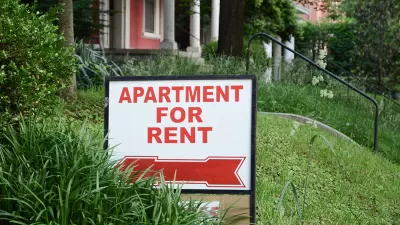The common metric for measuring housing affordability—whether households pay more than 30 percent of their income on shelter—has its downsides. Looking at residual income offers more precision in some respects.

A working paper from Harvard's Joint Center for Housing Studies examines housing affordability on the basis on residual income, a metric that's more sensitive to demographic differences in circumstance than the usual 30-percent standard. Chris Herbert and Daniel McCue write, "This alternative approach improves on the simple 30-percent standard by estimating the cost of 'everything else' as a function of the number and ages of all household members. It then estimates how much income would be available to pay for housing if those other costs were fully covered."
"In this framework," they go on, "the share of income that can be devoted to housing is not a single standard, but rather varies depending on both the size and composition of the household and the level of household income." That means a well-paid young professional may be devoting 50 percent of his or her income to rent, but still have more than enough for necessary and discretionary expenses, even in a high-cost city. The same would likely not be the case for someone earning low wages, or for a household with lots of kids.
The paper finds that compared to the residual income measure, the 30-percent standard often overstates affordability problems in high-cost markets, for high-income and smaller households. But overall levels of affordability remain similar in both models.
In a Slate article expanding on the topic, Henry Grabar writes that the 30-percent model "can't tell the difference between places where rents are growing too fast and those where incomes are growing too slowly—making it hard to tell if the problem is a housing shortage or the more entrenched issue of poverty and low wages."
FULL STORY: Is There a Better Way to Measure Housing Affordability?

Alabama: Trump Terminates Settlements for Black Communities Harmed By Raw Sewage
Trump deemed the landmark civil rights agreement “illegal DEI and environmental justice policy.”

Study: Maui’s Plan to Convert Vacation Rentals to Long-Term Housing Could Cause Nearly $1 Billion Economic Loss
The plan would reduce visitor accommodation by 25% resulting in 1,900 jobs lost.

Why Should We Subsidize Public Transportation?
Many public transit agencies face financial stress due to rising costs, declining fare revenue, and declining subsidies. Transit advocates must provide a strong business case for increasing public transit funding.

Wind Energy on the Rise Despite Federal Policy Reversal
The Trump administration is revoking federal support for renewable energy, but demand for new projects continues unabated.

Passengers Flock to Caltrain After Electrification
The new electric trains are running faster and more reliably, leading to strong ridership growth on the Bay Area rail system.

Texas Churches Rally Behind ‘Yes in God’s Back Yard’ Legislation
Religious leaders want the state to reduce zoning regulations to streamline leasing church-owned land to housing developers.
Urban Design for Planners 1: Software Tools
This six-course series explores essential urban design concepts using open source software and equips planners with the tools they need to participate fully in the urban design process.
Planning for Universal Design
Learn the tools for implementing Universal Design in planning regulations.
Caltrans
Smith Gee Studio
Institute for Housing and Urban Development Studies (IHS)
City of Grandview
Harvard GSD Executive Education
Toledo-Lucas County Plan Commissions
Salt Lake City
NYU Wagner Graduate School of Public Service





























